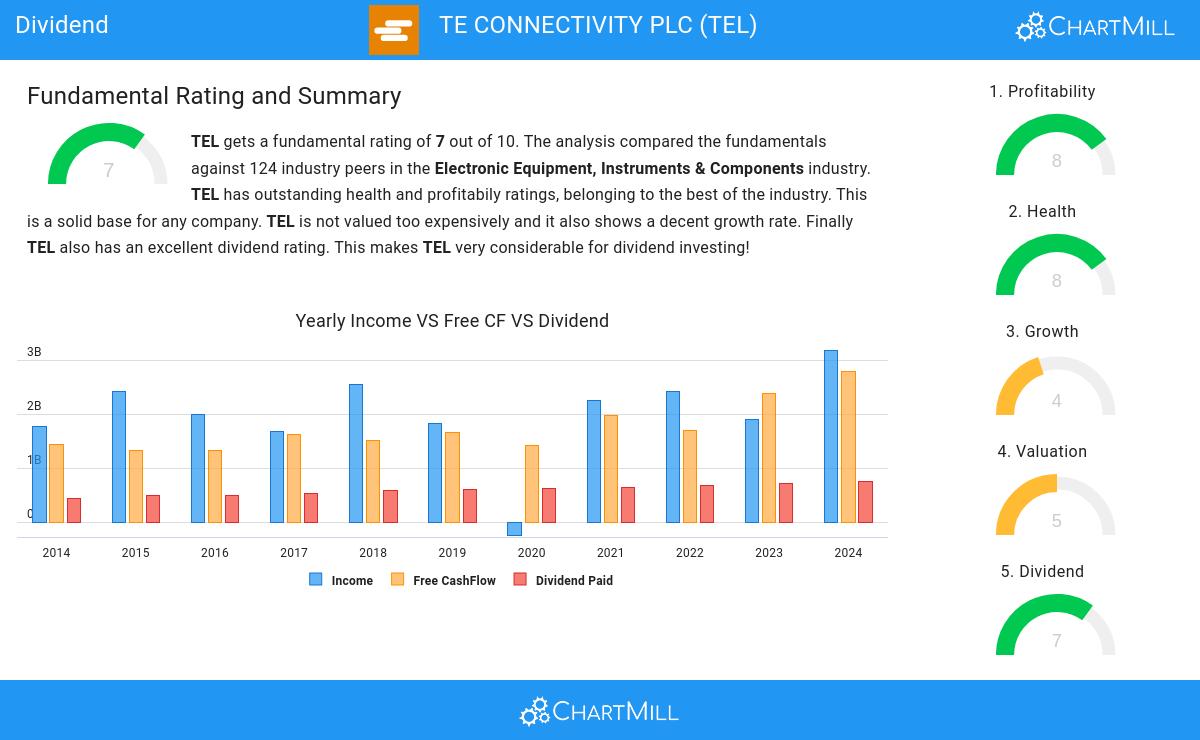Analyzing NYSE:TEL's Dividend Potential.
By Mill Chart
Last update: Nov 18, 2024
Unearth the potential of TE CONNECTIVITY PLC (NYSE:TEL) as a dividend stock recommended by our stock screening tool. NYSE:TEL maintains a robust financial footing and delivers a sustainable dividend. We'll delve into the details below.

Assessing Dividend Metrics for NYSE:TEL
To gauge a stock's dividend quality, ChartMill utilizes a Dividend Rating ranging from 0 to 10. This comprehensive assessment considers various dividend aspects, including yield, history, growth, and sustainability. NYSE:TEL has achieved a 7 out of 10:
- Compared to an average industry Dividend Yield of 1.93, TEL pays a better dividend. On top of this TEL pays more dividend than 93.50% of the companies listed in the same industry.
- On average, the dividend of TEL grows each year by 6.79%, which is quite nice.
- TEL has paid a dividend for at least 10 years, which is a reliable track record.
- TEL has not decreased their dividend for at least 10 years, which is a reliable track record.
- TEL pays out 23.80% of its income as dividend. This is a sustainable payout ratio.
What does the Health looks like for NYSE:TEL
A critical element of ChartMill's stock evaluation is the Health Rating, which spans from 0 to 10. This rating considers multiple health factors, including liquidity and solvency, both in absolute terms and relative to industry peers. NYSE:TEL has received a 8 out of 10:
- An Altman-Z score of 4.71 indicates that TEL is not in any danger for bankruptcy at the moment.
- TEL has a Altman-Z score of 4.71. This is in the better half of the industry: TEL outperforms 75.61% of its industry peers.
- The Debt to FCF ratio of TEL is 1.50, which is an excellent value as it means it would take TEL, only 1.50 years of fcf income to pay off all of its debts.
- The Debt to FCF ratio of TEL (1.50) is better than 78.86% of its industry peers.
- A Debt/Equity ratio of 0.27 indicates that TEL is not too dependend on debt financing.
- Although TEL does not score too well on debt/equity it has very limited outstanding debt, which is well covered by the FCF. We will not put too much weight on the debt/equity number as it may be because of low equity, which could be a consequence of a share buyback program for instance. This needs to be investigated.
- The current and quick ratio evaluation for TEL is rather negative, while it does have excellent solvency and profitability. These ratios do not necessarly indicate liquidity issues and need to be evaluated against the specifics of the business.
Assessing Profitability for NYSE:TEL
ChartMill utilizes a Profitability Rating to assess stocks, scoring them on a scale of 0 to 10. This rating takes into account a variety of profitability ratios and margins, both in absolute terms and in comparison to industry peers. NYSE:TEL has earned a 8 out of 10:
- TEL has a better Return On Assets (13.97%) than 95.94% of its industry peers.
- With an excellent Return On Equity value of 25.84%, TEL belongs to the best of the industry, outperforming 95.12% of the companies in the same industry.
- TEL has a better Return On Invested Capital (13.83%) than 91.87% of its industry peers.
- Measured over the past 3 years, the Average Return On Invested Capital for TEL is significantly above the industry average of 8.71%.
- TEL has a better Profit Margin (20.15%) than 96.75% of its industry peers.
- In the last couple of years the Profit Margin of TEL has grown nicely.
- TEL has a Operating Margin of 18.83%. This is amongst the best in the industry. TEL outperforms 96.75% of its industry peers.
- TEL's Operating Margin has improved in the last couple of years.
More Best Dividend stocks can be found in our Best Dividend screener.
Check the latest full fundamental report of TEL for a complete fundamental analysis.
Disclaimer
This article should in no way be interpreted as advice. The article is based on the observed metrics at the time of writing, but you should always make your own analysis and trade or invest at your own responsibility.
144.37
+0.85 (+0.59%)
Find more stocks in the Stock Screener
TEL Latest News and Analysis
 19 days ago - ChartmillIs TE CONNECTIVITY PLC (NYSE:TEL) suited for dividend investing?
19 days ago - ChartmillIs TE CONNECTIVITY PLC (NYSE:TEL) suited for dividend investing?Balancing Dividends and Fundamentals: The Case of TE CONNECTIVITY PLC (NYSE:TEL).


